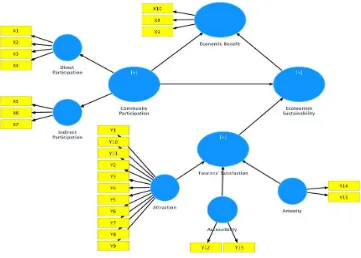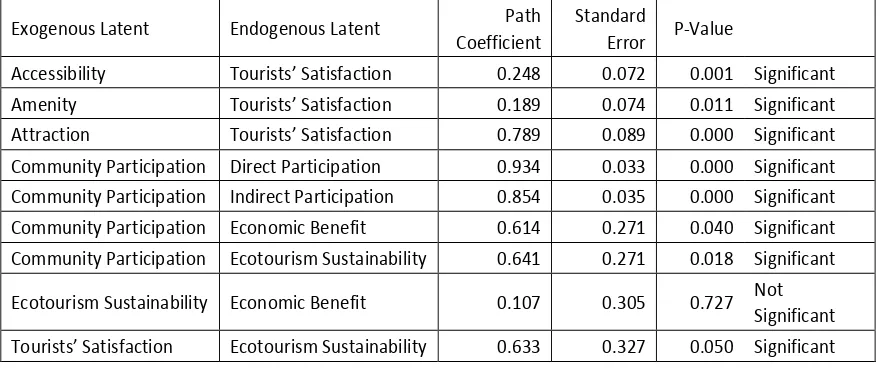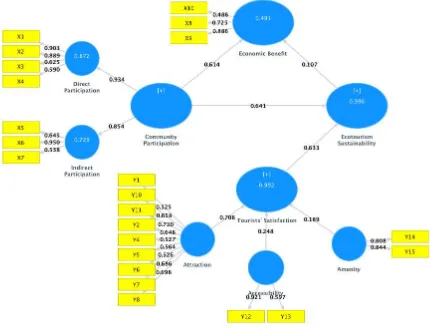Structural Model to Evaluate the Effect of Community Participation
on Ecotourism Sustainability
I Putu Eka N. Kencana Researcher
Tourism Research Consortium – Ministry of Research, Technology, and Higher Education, Indonesia [email protected]
Ni Putu Tresiani Manutami Graduate Student
Tourism Studies – Udayana Unversity, Bali, Indonesia [email protected]
G.K. Gandhiadi Senior Lecturer
Department of Mathematics, Faculty of Science – Udayana University, Bali, Indonesia [email protected]
Abstract
This paper aimed to study the effect of local community participation on ecotourism sustainability at Kiadan village, Badung regency of Bali, Indonesia. Two aspects regarding ecotourism sustainability has been studied, i.e. (a) economic benefits for local communities and (b) tourists’ satisfaction. By using partial least square, the data collected in July 2015 from local community leaders and tourist were analyzed. Four latent variables, namely (a) community participation, (b) economic benefits, (c) tourists’ satisfaction, and (d) ecotourism sustainability, were used to build structural model. The result shows community participation and tourists’ satisfaction proved significantly affect the sustainability of ecotourism at Kiadan, and community participation also affect the economic benefits of local communities.
Keywords: community participation, Partial Least Square (PLS), sustainability of ecotourism
Biographical Notes
I Putu Eka N. Kencana is a lecturer in the Department of Mathematics, University of Udayana at Bali, Indonesia where he teaches courses on tourism statistics and tourism modeling. He is also a
researcher at Tourism Research Consortium, Ministry of Research, Technology, and Higher Education, Indonesia. His research focuses on tourism modeling, fuzzy system, and sociometrics modeling.
Ni Putu Tresiani Manutami is a graduate student at Tourism Studies, University of Udayana at Bali, Indonesia. She received her undergraduate degree from Department of Mathematics, University of Udayana. Recently she is interested to study the behavior of local community at hinterland toward tourism.
Introduction
Many scholars argued sustainability of one area as tourist destination heavily depend on the involment and participation of local community at the tourism system in their villages (Tosun and Timothy, 2003; Choi and Sirakaya, 2006; Long, 2012). By taking participation in tourists’ activities, local people have chances to initiate and manage their small business that focus on servicing and supplying tourists’ needs. In addition, for people with lack of abilities to make business, they might be hired by business located around their village. In general, tourism give economic benefit for local people whom participate in tourism activities at their village, through direct or indirect participation (Tosun and Timothy, 2003).
Kiadan village at District of Petang, located at the northern part of Badung Regency, Province of Bali. Kiadan is one of total 27 indigenous villages at this district. Since 2002, the Kiadan village was
launched by local government as ecotourism village. This village is a highland region with the natural condition of the mountain. Natural green panorama with fresh air as well as the development of superior coffee plantations by the local community, causes Kiadan village has its own attraction, and therefore it starting and visited by foreign tourists. Moreover, the village is located on the path to tourist destination between Bedugul and Kintamani.
This research is motivated to elaborate and to study the relationship between local community participation and sustainability of ecotourism, especially in higland region of Bali. We focused our study on three main issues, namely (a) the effect of community participation on economic’s benefit gained by local people, (b) the effect of community participation and tourists’ satisfaction on ecotourism sustainability at Kiadan village, and (c) the effect of ecotourism sustainability on economic’s benefit of local people. Structural equation modeling (SEM) was applied to study these issues.
In brief, SEM is a method to find the relationship between latent variables that is belonged to multivariate statistical analysis as well as factor analysis that is common used by sosial researcher (Hair et al., 2012). According to Bollen (2002) and Tenenhaus et al. (2005), SEM is a powerfull technique to study latent or construct, variable that can not be measured directly. Latent variable usually measured by its indicator or manifest.
Research Method
The primary data used in this research is obtained by using questionnaires from local people who participate in the management of Kiadan Village Ecotourism and tourists that visiting Kiadan Village ecotourism on Mey – July 2015. The amount of sample to be used is as much as 120 respondents, 60 samples were taken from the local community and another 60 were taken from the tourists who visited Kiadan village.
There were seven first-order latent variables, namely (a) direct participation, (b) indirect
Figure 1. Conceptual Model of Research
Referring to the literature relating to community-based ecotourism, a survey instrument was developed to this study. Several items were developed for each indicator in the model. Pilot study was conducted to measure instrument’s realiability and items’ validity. The questionnaire items with five level Likert scale were assessed by examining the Cronbach’s alpha coefficient and total-item correlation. The operation model was depicted in Figure 2:
Result and Discussion
At the beginning phase of analysis, we tested the validity and reliability of the research instrument. An item in the instrument is declared invalid, if the value of the correlation coefficient between the item question with a total score is gerater than 0,30 (Churchill, 1979). Furthermore, a measurement instrument is called reliable if the value of Cronbach Alpha ≥ 0.60 (Hair et al., 2012).
Using Statistical Package for Social Sience (SPSS) 19.0, we found all of the first-ordered latent variables were reliable. Only item Y3 and Y9 had correlation coefficient below the threshold valued suggested by Churchill (1979), with coefficients as much as 0,270 and 0,282; respectively. From these findings, we concluded to eliminates Y3 and Y9 from subsequent analysis.
Briefly, SEM analysis can be classified into outer or measurement model analysis and inner or structural model analysis. Measurement model analysis is conducted to assess latent variables with reflective indicator in terms of their observed or manifest variables (Hox and Bechger, 1998; Hair et al., 1995). Typically, this is done by observing Cronbach’s alpha and composite reliability. At the construct level, convergent validity be assessed by examining whether the average variance
extracted (AVE) greater than 0.50 (Peng and Lai, 2012); and at item level the factor loadings are high (greater than 0.60) (Hair et al., 1995) and significant (Peng and Lai, 2012).
From the measurement model analysis, we counted the factor loadings, t-values, AVE, and composite reliability (CR) for all of latents with reflective manifests after Y3 and Y9 have been dropped using SmartPLS 3.2.3 (Ringle, Wende and Will, 2005). At the item level, all of the factor loadings exceeded 0.50 and were statistically significant at 5% and proved the measurement model achieved convergent validity. In addition, all of the CR’s values exceeded 0.60 showing a high level of internal consistency for the latent variables. Moreover, all of the AVE’s values greater than 0.50, showing the measurement achieved convergent validity at the item level and also discriminant validity at the construct level. From these findings, we concluded this research had appropriate levels of convergent and discriminant validity and structural model analysis worth to be conducted.
After knowing the measurement model had appropriate criteria, we analyzed the structural model to determine the causal relationship between exogenous and endogenous latent variables. The result summarized in Table 1:
Table 1. The Value of Path Coefficient Between Exogenous and Endogenous Latent Variables in Structural Model
Exogenous Latent Endogenous Latent Path
Coefficient
Standard
Error P-Value
Accessibility Tourists’ Satisfaction 0.248 0.072 0.001 Significant Amenity Tourists’ Satisfaction 0.189 0.074 0.011 Significant Attraction Tourists’ Satisfaction 0.789 0.089 0.000 Significant
Community Participation Direct Participation 0.934 0.033 0.000 Significant Community Participation Indirect Participation 0.854 0.035 0.000 Significant Community Participation Economic Benefit 0.614 0.271 0.040 Significant Community Participation Ecotourism Sustainability 0.641 0.271 0.018 Significant
Ecotourism Sustainability Economic Benefit 0.107 0.305 0.727 Not Significant Tourists’ Satisfaction Ecotourism Sustainability 0.633 0.327 0.050 Significant
The final structural equation model with all of direct effects is depicted in Figure3:
Figure 3. Path Coefficients of Causal Relationship in the Structural Equation Model
Referring to Figure 3 and Table 1, both reflective first-order latent of community participation had significantly path coefficient. The path value for direct participation is greater than indirect
participation that means direct participation outperformed indirect participation of Kiadan’s people in ecotourism activities. Moreover, attraction provided by ecotourism industries at Kiadan village dominates accessibility and amenity factors in forming tourists’ satisfaction although all of these first-order latent variables proved significantly affect tourists’ satisfaction.
The results also states the causal relationships between main latent variables (community participation, tourists’ satisfaction, ecotourism sustainability, and economic benefit) reflect significant and not significant effects. Sustainability of Kiadan’s ecotourism proved significantly affected by community participation and tourists’ satisfaction althouth effect arose from participation slightly greater than effect arose from tourists’ satisfaction (path values for participation and tourists’ satisfaction as much as 0,641 and 0, 633; respectively).
Conclusion
Based on the results obtained, we concluded that the community participation and satisfaction of tourists who visited the Kiadan Village had significant effects on sustainability of Kiadan village ecotourism. Meanwhile, although participation of community proved significantly affect the economic benefits received by the local communities, the sustainability of ecotourism at this village did not affect significantly the economic benefit.
Bibliography
Tosun, C. and Timothy, D.J. (2003) 'Community Participation in the Tourism Development Process',
Journal of Tourism Studies, vol. 14, no. 2, December, pp. 1-15.
Long, P.H. (2012) 'Tourism Impacts and Support for Tourism Development in Ha Long Bay, Vietnam: An Examination of Resident's Perceptions', Asian Social Science, vol. 8, no. 8, July, pp. 28-39.
Choi, H.C. and Sirakaya, E. (2006) 'Sustainability indicators for managing community tourism',
Tourism Management, vol. 27, pp. 1275-1289.
Untong, A., Kaosa-Ard, M., Ramos, V., Sangkakorn, K. and Rey-Maquieira, J. (2010) 'Factors Influencing Local Resident Support for Tourism Development: A Structural Equation Model', The APTA Conference, Macau, China, 1-21.
Hair, J.F., Sarstedt, M., Ringle, C.M. and Mena, J.A. (2012) 'An assessment of the use of partial least squares structural equation modeling in marketing research', Journal of Academic Marketing Science, vol. 40, pp. 414-433.
Bollen, K.A. (2002) 'Latent Variables in Psychology and the Social Sciences', Annual Review of Psychological, vol. 53, pp. 605-634.
Tenenhaus, M., Vinzi, V.E., Chatelin, Y.-M. and Lauro, C. (2005) 'PLS path modeling', Computational Statistics & Data Analysis, vol. 48, pp. 159-205.
Churchill, G.A. (1979) 'A Paradigm for Developing Better Measures of Marketing Constructs', Journal of Marketing Research, vol. 16, no. 1, February, pp. 64-73.
Hox, J.J. and Bechger, T.M. (1998) 'An Introduction to Structural Equation Modeling', Family Science Review, vol. 11, pp. 354-373.
Hair, J.F., Anderson, R.E., Tatham, R.L. and Black, W.C. (1995) Multivariate Data Analysis with Readings, 4th edition, New Jersey: Prentice-Hall, Inc.
Peng, D.X. and Lai, F. (2012) 'Using partial least squares in operations management research: A practical guideline and summary of past research', Journal of Operation Management, vol. 30, pp. 467-480.
Ringle, C.M., Wende, S. and Will, A. (2005) SmartPLS 2.0, [Online], Available:


